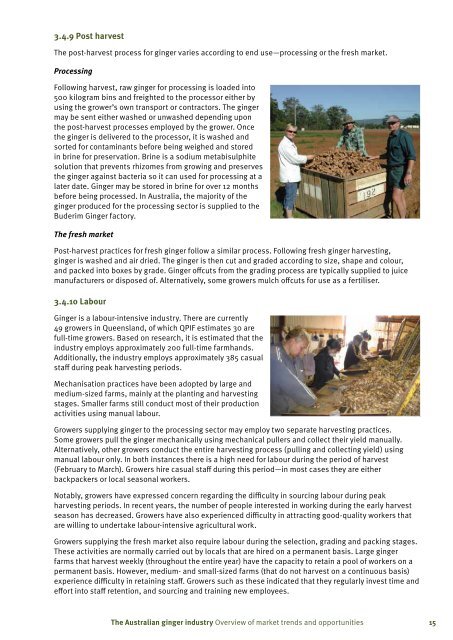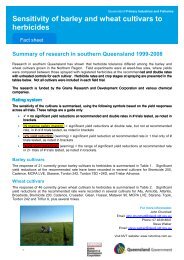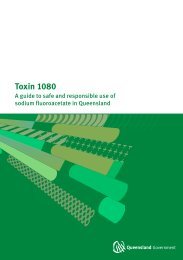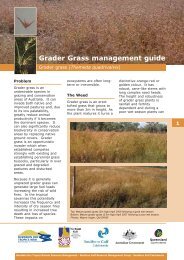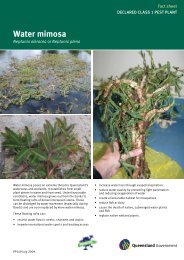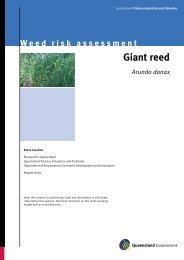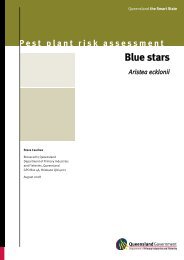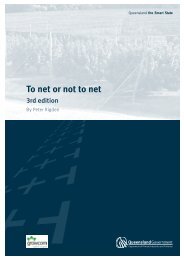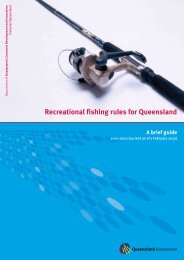The Australian ginger industry - Department of Primary Industries
The Australian ginger industry - Department of Primary Industries
The Australian ginger industry - Department of Primary Industries
You also want an ePaper? Increase the reach of your titles
YUMPU automatically turns print PDFs into web optimized ePapers that Google loves.
3.4.9 Post harvest<br />
<strong>The</strong> post-harvest process for <strong>ginger</strong> varies according to end use—processing or the fresh market.<br />
Processing<br />
Following harvest, raw <strong>ginger</strong> for processing is loaded into<br />
500 kilogram bins and freighted to the processor either by<br />
using the grower’s own transport or contractors. <strong>The</strong> <strong>ginger</strong><br />
may be sent either washed or unwashed depending upon<br />
the post-harvest processes employed by the grower. Once<br />
the <strong>ginger</strong> is delivered to the processor, it is washed and<br />
sorted for contaminants before being weighed and stored<br />
in brine for preservation. Brine is a sodium metabisulphite<br />
solution that prevents rhizomes from growing and preserves<br />
the <strong>ginger</strong> against bacteria so it can used for processing at a<br />
later date. Ginger may be stored in brine for over 12 months<br />
before being processed. In Australia, the majority <strong>of</strong> the<br />
<strong>ginger</strong> produced for the processing sector is supplied to the<br />
Buderim Ginger factory.<br />
<strong>The</strong> fresh market<br />
Post-harvest practices for fresh <strong>ginger</strong> follow a similar process. Following fresh <strong>ginger</strong> harvesting,<br />
<strong>ginger</strong> is washed and air dried. <strong>The</strong> <strong>ginger</strong> is then cut and graded according to size, shape and colour,<br />
and packed into boxes by grade. Ginger <strong>of</strong>fcuts from the grading process are typically supplied to juice<br />
manufacturers or disposed <strong>of</strong>. Alternatively, some growers mulch <strong>of</strong>fcuts for use as a fertiliser.<br />
3.4.10 Labour<br />
Ginger is a labour-intensive <strong>industry</strong>. <strong>The</strong>re are currently<br />
49 growers in Queensland, <strong>of</strong> which QPIF estimates 30 are<br />
full-time growers. Based on research, it is estimated that the<br />
<strong>industry</strong> employs approximately 200 full-time farmhands.<br />
Additionally, the <strong>industry</strong> employs approximately 385 casual<br />
staff during peak harvesting periods.<br />
Mechanisation practices have been adopted by large and<br />
medium-sized farms, mainly at the planting and harvesting<br />
stages. Smaller farms still conduct most <strong>of</strong> their production<br />
activities using manual labour.<br />
Growers supplying <strong>ginger</strong> to the processing sector may employ two separate harvesting practices.<br />
Some growers pull the <strong>ginger</strong> mechanically using mechanical pullers and collect their yield manually.<br />
Alternatively, other growers conduct the entire harvesting process (pulling and collecting yield) using<br />
manual labour only. In both instances there is a high need for labour during the period <strong>of</strong> harvest<br />
(February to March). Growers hire casual staff during this period—in most cases they are either<br />
backpackers or local seasonal workers.<br />
Notably, growers have expressed concern regarding the difficulty in sourcing labour during peak<br />
harvesting periods. In recent years, the number <strong>of</strong> people interested in working during the early harvest<br />
season has decreased. Growers have also experienced difficulty in attracting good-quality workers that<br />
are willing to undertake labour-intensive agricultural work.<br />
Growers supplying the fresh market also require labour during the selection, grading and packing stages.<br />
<strong>The</strong>se activities are normally carried out by locals that are hired on a permanent basis. Large <strong>ginger</strong><br />
farms that harvest weekly (throughout the entire year) have the capacity to retain a pool <strong>of</strong> workers on a<br />
permanent basis. However, medium- and small-sized farms (that do not harvest on a continuous basis)<br />
experience difficulty in retaining staff. Growers such as these indicated that they regularly invest time and<br />
effort into staff retention, and sourcing and training new employees.<br />
<strong>The</strong> <strong>Australian</strong> <strong>ginger</strong> <strong>industry</strong> Overview <strong>of</strong> market trends and opportunities 15


